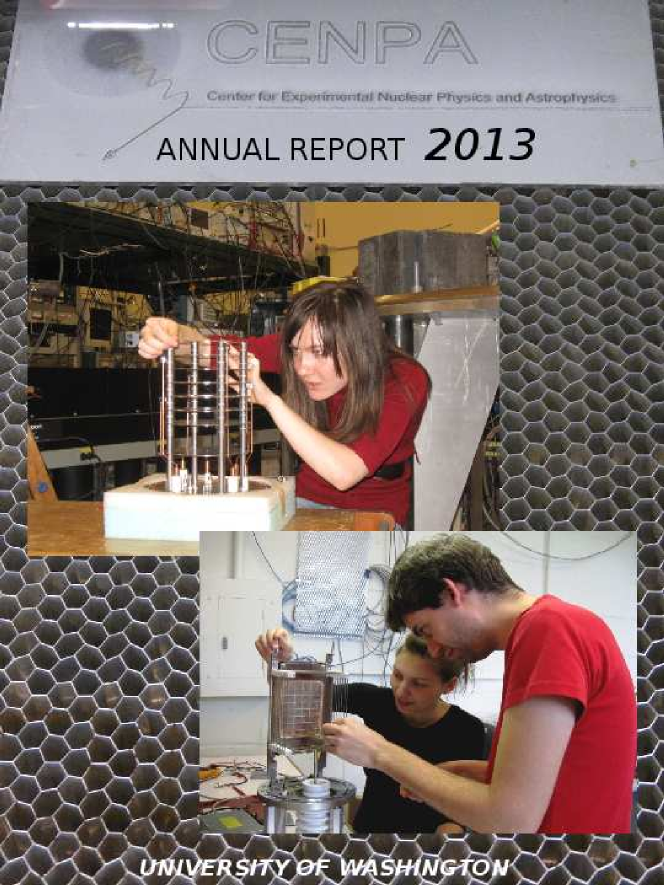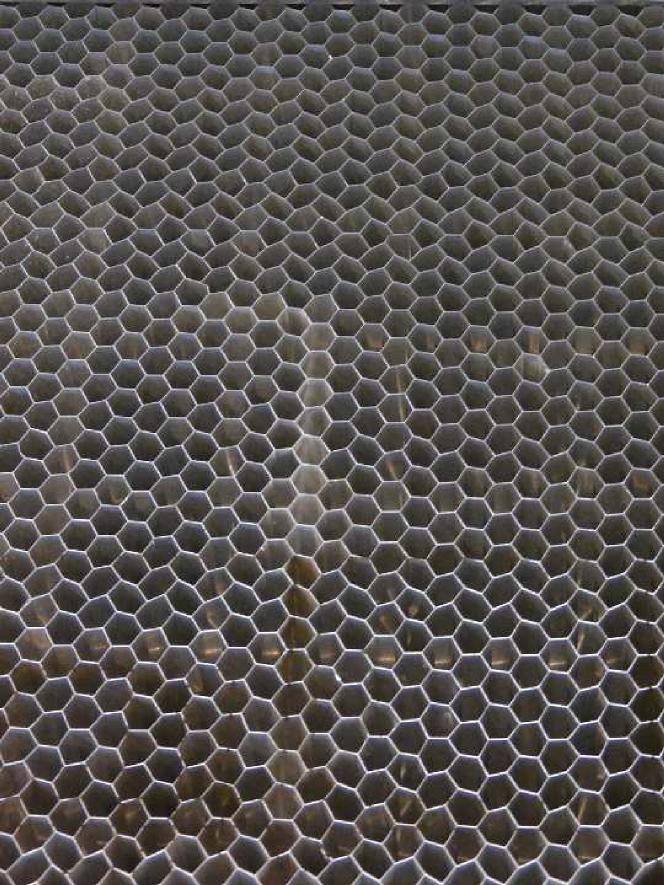Annual Report File:
Description:
ANNUAL REPORT
Center for Experimental Nuclear Physics and Astrophysics
University of Washington
April, 2013
Sponsored in part by the United States Department of Energy under Grant #DE-FG02-97ER41020.
This report was prepared as an account of work sponsored in part by the United States Government. Neither the United States nor the United States Department of Energy, nor any of their employees, makes any warranty, expressed or implied or assumes any legal liability or responsibility for accuracy, completeness or usefulness of any information, apparatus, product or process disclosed, or represents that its use would not infringe on privately-owned rights.
INTRODUCTION
1 Neutrino Research
KATRIN
1.1 Overview of the KATRIN experiment
1.2 Status of the KATRIN experiment
1.3 Detector dead-layer analysis
1.4 Detector commissioning at KIT
1.5 Operator training
1.6 System upgrades
1.7 Detector response simulation
1.8 Analysis tools
1.9 Tritium Recoil-Ion Mass Spectrometer
MAJORANA
1.10 Overview of the MAJORANA DEMONSTRATOR
1.11 Simulation and analysis activities for the MAJORANA DEMONSTRATOR
1.12 Low-background cable connectors for MAJORANA
1.13 Picocoax®; high voltage cable testing
1.14 Low-background parylene coating and gasket production
1.15 Preamplifier with forward-biased reset for CoGeNT and MAJORANA
1.16 MAJORANA single-string-test cryostat
SNO+
1.17 Overview of the SNO+ experiment and CENPA’s contribution
1.18 SNO+ data acquisition software
1.19 SNO+ slow control and monitoring tools
1.20 Measurement of light scattering in liquid scintillators considered for SNO+
HALO
1.21 The HALO supernova detector
Project 8
1.22 Status of the Project 8 neutrino mass experiment
2 Fundamental symmetries and non-accelerator-based weak interactions
Torsion-balance experiments
2.1 Overview of the CENPA torsion-balance experiments
2.2 Progress on a rotating torsion-balance test of the equivalence principle
2.3 NewWash FPGA rotation controller
2.4 NewWash torsion-balance upgrade
2.5 New bounds on ISL deviations from the Fourier-Bessel experiment
2.6 Upgrade of the Fourier-Bessel short-range gravity experiment
2.7 Parallel-plate inverse-square law test
2.8 Constraints on long-range, macroscopic spin-dependent forces
2.9 First data and preliminary results from a search for short-range spin-coupled forces
2.10 Progress toward a hydrogen-rich equivalence-principle pendulum
2.11 Development of a second-generation hydrogen-rich equivalence-principle pendulum
2.12 Outgassing measurements of plastic test bodies
2.13 Status of the cryogenic torsion balance
2.14 Continued development of a dedicated gravity gradiometer system
2.15 Multi-slit autocollimator
2.16 Improved interferometric quasi-autocollimator
2.17 Progress on development of a precision tiltmeter for advanced LIGO
Non-accelerator-based weak interactions
2.18 Calibrations for the UCNA experiment and foil thickness measurements at CENPA
2.19 Search for an electric dipole moment of 199Hg
Torsion-balance experiments
2.1 Overview of the CENPA torsion-balance experiments
2.2 Progress on a rotating torsion-balance test of the equivalence principle
2.3 NewWash FPGA rotation controller
2.4 NewWash torsion-balance upgrade
2.5 New bounds on ISL deviations from the Fourier-Bessel experiment
2.6 Upgrade of the Fourier-Bessel short-range gravity experiment
2.7 Parallel-plate inverse-square law test
2.8 Constraints on long-range, macroscopic spin-dependent forces
2.9 First data and preliminary results from a search for short-range spin-coupled forces
2.10 Progress toward a hydrogen-rich equivalence-principle pendulum
2.11 Development of a second-generation hydrogen-rich equivalence-principle pendulum
2.12 Outgassing measurements of plastic test bodies
2.13 Status of the cryogenic torsion balance
2.14 Continued development of a dedicated gravity gradiometer system
2.15 Multi-slit autocollimator
2.16 Improved interferometric quasi-autocollimator
2.17 Progress on development of a precision tiltmeter for advanced LIGO
Non-accelerator-based weak interactions
2.18 Calibrations for the UCNA experiment and foil thickness measurements at CENPA
2.19 Search for an electric dipole moment of 199Hg
3 Accelerator-based physics
Nuclear structure
3.1 Overview of the nuclear-structure experiments at CENPA
3.2 6He Lifetime and gA in nuclei
3.3 Preparations for an 36Ar(3He,α)35Ar experiment and the role of 34Ar(p,γ)35Ar in novae
3.4 Electron capture on 116In and nuclear structure related to 2β decay
Accelerator-based weak interactions
3.5 Overview of the 6He experiments at CENPA
3.6 Beta detector for the 6He experiment
3.7 Laser setup for the 6He experiment
3.8 Electric-Field systems and ion-detection setup for the 6He experiment
3.9 The 6He experiment and limits on tensor-type weak currents from nuclear and neutron β decays
3.10 Tests of radioactivity production for the 6He experiment
3.11 7Li target monitoring system for the 6He experiment
Nuclear structure
3.1 Overview of the nuclear-structure experiments at CENPA
3.2 6He Lifetime and gA in nuclei
3.3 Preparations for an 36Ar(3He,α)35Ar experiment and the role of 34Ar(p,γ)35Ar in novae
3.4 Electron capture on 116In and nuclear structure related to 2β decay
Accelerator-based weak interactions
3.5 Overview of the 6He experiments at CENPA
3.6 Beta detector for the 6He experiment
3.7 Laser setup for the 6He experiment
3.8 Electric-Field systems and ion-detection setup for the 6He experiment
3.9 The 6He experiment and limits on tensor-type weak currents from nuclear and neutron β decays
3.10 Tests of radioactivity production for the 6He experiment
3.11 7Li target monitoring system for the 6He experiment
4 Precision muon physics
4.1 Overview of the muon physics program
MuCap
4.2 The final result of the MuCap experiment
MuSun
4.3 Muon capture on deuterium, the MuSun experiment
4.4 Hardware developments at UW towards the 2013 production run
4.5 The 2012 run, moving into the new πE1 area
4.6 Analysis of R2011 data
4.7 Status of the Monte Carlo simulation
g - 2
4.8 Overview of the g - 2 experiment
4.9 Detector laboratory developments and simulation studies
4.10 Lead fluoride crystal (PbF2) transmission diagnostic tests
4.11 Optimizing injection efficiency
4.12 Overview and progress of the field team
4.13 Preparations for restoring the NMR field-measurement system
4.14 Cross-section measurements via initial-state radiation at Belle
4.15 Contribution to the magnetic dipole moment of the muon from Belle data
AlCap
4.16 Charged-particle emission after muon capture: the AlCap experiment
4.1 Overview of the muon physics program
MuCap
4.2 The final result of the MuCap experiment
MuSun
4.3 Muon capture on deuterium, the MuSun experiment
4.4 Hardware developments at UW towards the 2013 production run
4.5 The 2012 run, moving into the new πE1 area
4.6 Analysis of R2011 data
4.7 Status of the Monte Carlo simulation
g - 2
4.8 Overview of the g - 2 experiment
4.9 Detector laboratory developments and simulation studies
4.10 Lead fluoride crystal (PbF2) transmission diagnostic tests
4.11 Optimizing injection efficiency
4.12 Overview and progress of the field team
4.13 Preparations for restoring the NMR field-measurement system
4.14 Cross-section measurements via initial-state radiation at Belle
4.15 Contribution to the magnetic dipole moment of the muon from Belle data
AlCap
4.16 Charged-particle emission after muon capture: the AlCap experiment
5 Axion searches
ADMX
5.1 Status of the ADMX experiment
ADMX
5.1 Status of the ADMX experiment
6 Relativistic Heavy Ions
6.1 UW URHI program overview
6.2 Challenging claims for “elliptic flow” from RHIC heavy ion collisions
6.3 A p-p “Glauber model” – centrality b vs soft gluon x
6.4 p-p angular correlation systematics vs low-x gluons
6.5 nch dependence of angular correlations and η distributions for particles produced in 200-GeV p-p collisions
6.6 Transverse multiplicity N⊥(pt) systematics for 200-GeV p-p collisions
6.7 Jet angular correlations and the p-p underlying event
6.8 nch dependence of trigger spectra from 200-GeV p-p collisions
6.9 Modeling 1D trigger spectra from 200-GeV p-p collisions
6.10 nch dependence of trigger-associated distributions from 200-GeV p-p collisions
6.11 Modeling 2D trigger-associated correlations from p-p collisions
6.12 Hard components from 2D trigger-associated correlations vs pQCD
6.13 The p-p underlying event and trigger-associated jet correlations
6.1 UW URHI program overview
6.2 Challenging claims for “elliptic flow” from RHIC heavy ion collisions
6.3 A p-p “Glauber model” – centrality b vs soft gluon x
6.4 p-p angular correlation systematics vs low-x gluons
6.5 nch dependence of angular correlations and η distributions for particles produced in 200-GeV p-p collisions
6.6 Transverse multiplicity N⊥(pt) systematics for 200-GeV p-p collisions
6.7 Jet angular correlations and the p-p underlying event
6.8 nch dependence of trigger spectra from 200-GeV p-p collisions
6.9 Modeling 1D trigger spectra from 200-GeV p-p collisions
6.10 nch dependence of trigger-associated distributions from 200-GeV p-p collisions
6.11 Modeling 2D trigger-associated correlations from p-p collisions
6.12 Hard components from 2D trigger-associated correlations vs pQCD
6.13 The p-p underlying event and trigger-associated jet correlations
7 Other research
7.1 Status of nonlocal quantum communication test
7.2 Energy deposition and micro dosimetry in water for fast ions in radiation therapy
7.1 Status of nonlocal quantum communication test
7.2 Energy deposition and micro dosimetry in water for fast ions in radiation therapy
8 Education
8.1 Use of CENPA facilities in education and course work at UW
8.2 Accelerator-based lab class in nuclear physics
8.3 Radiochemistry and nuclear-chemistry education program in the
UW Department of Chemistry
8.4 Student training
8.1 Use of CENPA facilities in education and course work at UW
8.2 Accelerator-based lab class in nuclear physics
8.3 Radiochemistry and nuclear-chemistry education program in the
UW Department of Chemistry
8.4 Student training
9 Facilities
9.1 Facilities overview
9.2 Van de Graaff accelerator and ion source operations and development
9.3 Laboratory computer systems
9.4 Electronic equipment
9.5 New computer-controlled fabrication tools for student use
9.6 CENPA instrument shops
9.7 Building upgrades
9.1 Facilities overview
9.2 Van de Graaff accelerator and ion source operations and development
9.3 Laboratory computer systems
9.4 Electronic equipment
9.5 New computer-controlled fabrication tools for student use
9.6 CENPA instrument shops
9.7 Building upgrades
10 CENPA Personnel
10.1 Faculty
10.2 CENPA External Advisory Committee
10.3 Postdoctoral Research Associates
10.4 Predoctoral Research Associates
10.5 NSF Research Experience for Undergraduates participants
10.6 University of Washington graduates taking research credit
10.7 University of Washington undergraduates taking research credit
10.8 Professional staff
10.9 Technical staff
10.10 Administrative staff
10.11 Part-time staff and student helpers
10.1 Faculty
10.2 CENPA External Advisory Committee
10.3 Postdoctoral Research Associates
10.4 Predoctoral Research Associates
10.5 NSF Research Experience for Undergraduates participants
10.6 University of Washington graduates taking research credit
10.7 University of Washington undergraduates taking research credit
10.8 Professional staff
10.9 Technical staff
10.10 Administrative staff
10.11 Part-time staff and student helpers
11 Publications
11.1 Published papers
11.2 Reports and white papers
11.3 Abstracts and contributed talks
11.4 Papers submitted or to be published
11.5 Invited talks, abstracts, and other conference presentations
11.6 Book Publications
11.7 Ph.D. degrees granted
11.1 Published papers
11.2 Reports and white papers
11.3 Abstracts and contributed talks
11.4 Papers submitted or to be published
11.5 Invited talks, abstracts, and other conference presentations
11.6 Book Publications
11.7 Ph.D. degrees granted
Cover:


